Water lily vs lotus is a popular topic among gardeners as both of these plants have beautiful leaves and flowers that are noticeable on the water’s surface.
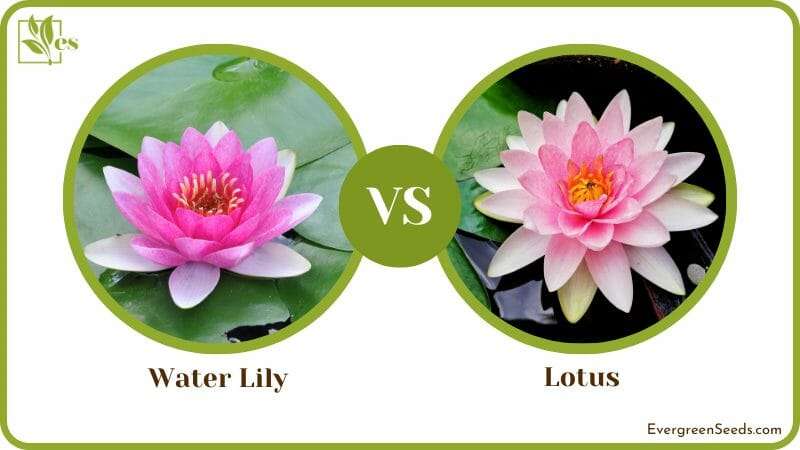
While there are many comparable features between these two plants at a glance, there are notable differences that are present as well.
The purpose of this article is to compare and contrast the water lily versus lotus, thereby making it easy for you to distinguish one from the other. Let’s dive into the article!
JUMP TO TOPIC
Water Lily vs Lotus Comparison Table
Here is a quick comparison table for the water lily and lotus plants.
| Features | Water Lily | Lotus |
| Family | Nymphaeaceae | Nelumbonaceae |
| Aquatic types | Tropical and hardy | Nelumbo nucifera, Nelumbo nutea |
| Floating or Emergent | Leaves and flowers floating on water surface | Leaves and flowers are emergent from water |
| Leaves | Thicker, waxy, with a cut from the edge to the center | Thin and papery |
| Flowers | Thicker, waxy, pointed petals, star blooms | Rounded petals, barrel-shaped carpel |
| Seed ripening | Takes place underwater | Takes place above the water |
| Height | Shorter | Taller |
| Variegation | Some have variegated leaves | Consistent green color |
| Environmental preferences | Shallow water, about two to five feet deep. | Deeper water, about 12 feet deep |
| Fragrances | More defined and stronger | Less defined |
| Fertilizer requirements | Lower fertilizer requirements | Require more fertilizer |
What Is the Difference Between Lotus and Water Lily?
The main difference between the water lily and lotus is that the lotus leaves and flowers rise above the surface of the water, while those of the water lily float on the surface of the water.
Only one species of water lily does not respect the floating rule, which is the tropical water lily. The leaves of this lily type float on water but the flower goes further off the surface of the water. This flower can go as far as six to eight inches above the water’s surface.
– Water Lily and Lotus: What Are the Similarities?
The water lily and lotus are some of the most gorgeous flowering plants that grow in water. The fact that they are both grown in water makes it even more difficult to differentiate these two plants.
However, if you have never seen the water lily and lotus before, you might want to know some of the similarities that make these plants relatively comparable. Therefore, before we delve into the differences between these plants, we will explore their similarities first.
– Flowers
The lotus and water lily appear similar when you look at their flowers. Unless you are aware of the differences between the flowers of these plants, you might not be able to distinguish between them.
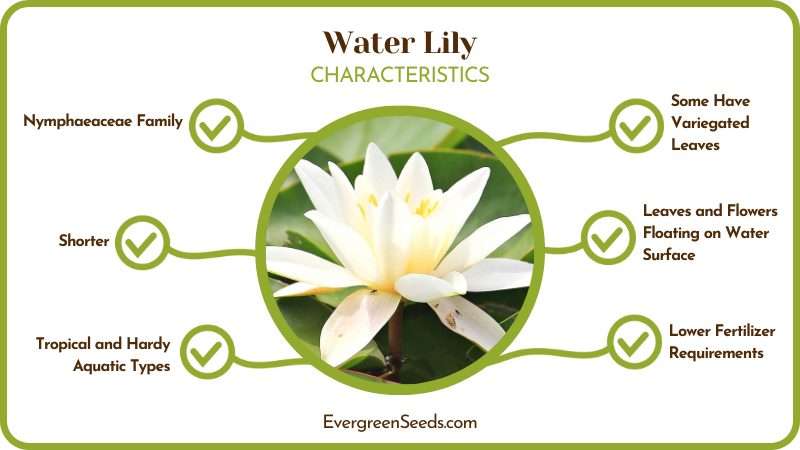
Both the water lily and lotus can have white flowers. However, the water lily may also adopt the rose color on its flowers, while the lotus flower can be pink.
– Dwarf Varieties
Both the lotus and water lily are dwarf varieties, which is why these plants are perfect for patio ponds. Sometimes, these plants can be small enough to fit in patio tabletop bowls.
– Invasion
The water lily is very invasive because it grows quite fast. This plant can easily fill up a space in no time. The same applies to the lotus, so although this plant is grown in home ponds, care should be taken to control it from taking over its environment.
– Symbolism
There are many plants out there whose existence is not attached or associated with any symbolism. However, both the water lily and lotus are among those plants that are held in high regard as far as symbolism is concerned. The flowers of the two plants are symbolic of good things.
The lotus flower is regarded as a symbol of fertility, beauty and wealth. In Hinduism, they believe that every individual has a spirit of the holy lotus flower inside them, thereby associating this flower with life and existence. Feminine beauty, especially the eyes of women, can be described with reference to the lotus flower.
The water lily is also regarded as symbolic of beauty. Unity, peace and finding balance are believed to be well-represented by the existence of a water lily. Buddhists regard the water lily flower as a symbol of rising from the mundane to the spiritual world. Interestingly, the water lily is known as the official birth flower for the month of July.
– Nutritional Value of Seeds
Did you know that the seeds of both the lotus and water lily are highly nutritious? They are both prepared by frying, milling and boiling to make meals that are healthy. You can even make your nutritious snacks from the seeds of these plants.
What Is the Water Lily Best For?
One of the best things that you will find on the water lily is the variegation on its leaves. This attribute sways the appearance of this plant from the usual plain green color that the lotus has. Let’s find out more intriguing characteristics of the water lily in this section.
– Growth and Care Requirements
The care requirements of the water lily and lotus plants also differ. For instance, the fertilizer requirements for the water lily are far much less than those for the lotus plant. The lotus is more demanding in its care and feeding.
This might be attributed to the larger size of the plant. The water lily can grow well when it is provided with a lot of sunlight, even when it is under a shade.
– Variegation
Some varieties of the water lily are variegated, though there are some that are not. A greater part of these variegated water lilies have foliage that is tinged with a dark purple color or may appear completely purple at times. Such variegation is common with the tropical types of water lilies.
The case isn’t the same when we look at the lotus plants. The leaves of this plant have a consistent green color. The other vivid colors are only evident on the flowers.
– Seed Ripening
The seeds of the water lily ripen under the water. This is because the inflorescence of the plant does not go beyond the surface of the water.
Once the seed pod of the water lily forms, it falls into the water. The pod of the water lily will ripen and open under the water to release the mature seeds that will then germinate.
– Fragrance
The scent of the water lily is strong, especially when the plant blooms. The scent gradually fades away as the inflorescence disappears. Due to this attribute, the water lily is more likely to attract more insects much easily because of its stronger scent.
– Leaf Attributes
The leaves of the water lily are thick and waxy. You can also easily identify a water lily by the cut that runs from the edges of its leaves to the center. Water that falls onto the surface of water lily leaves quickly drains into the pond through the cut.
Another recognizable characteristic of the water lily leaves is the notch that is found on each of the water lilies leaves.
– Flower Characteristics
Just like the leaves, the flowers off a water lily are much thicker and waxier compared to those of the lotus. Moreover, water lilies have petals that are pointed in shape. This leads to the production of star-like blooms by the plant. The petals of the water lily are also thinner and smaller when they are brought in comparison with those of the lotus.
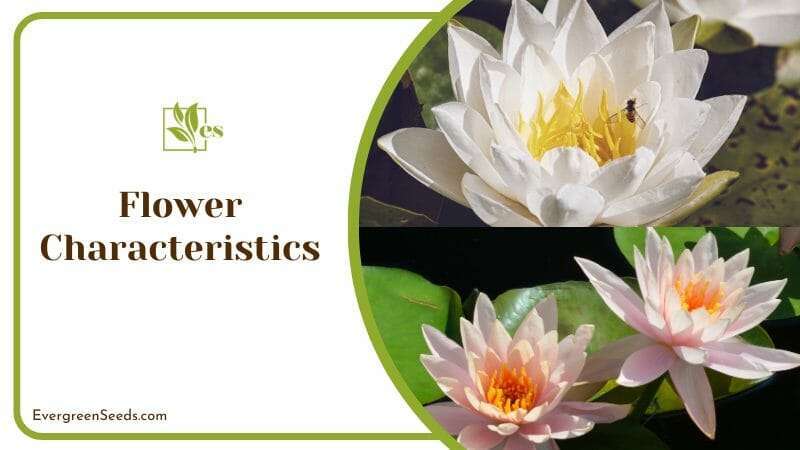
Another interesting difference is that the flowers of a water lily will stick around for about two weeks, a time frame that is much longer than that of a lotus flower. After this period, the water lily flower will wilt and fall under the water.
The center of the water lily flower is typical of the flowers of other plants, with the stamens and pistils located there.
– Water Lily: An Overview
Water lilies belong to the Nymphaeaceae family of plants, which are flowering plants that grow in fresh water. Water lilies are native to tropical and temperate regions of the globe.
The water lily exists in two main types, which are the hardy and tropical. Suppose you were to plant these two types of water lily below freezing lines in the water, the hardy lily would survive but not the tropical one. The tropical water lilies can be regarded as annuals because they need to be stored over the winter.
The other differences that you might need to take note of are that the tropical water lilies have longer flower stalks as well as larger flowers and lily pads. Therefore, the tropical water lilies have lotus-like flowers more than the hardy ones.
The tropical water lilies also have stronger scents and may come in a variety of colors. Another fascinating difference is that tropical water lilies can be either day or night-blooming varieties, while the hardy ones can only be day-blooming.
What Is the Lotus Best For?
The lotus is best for the applications of its flower, which include destroying cancer cells and some microorganisms, reducing swelling and blood sugar, as well as protecting the heart, blood vessels, liver, skin and brain.
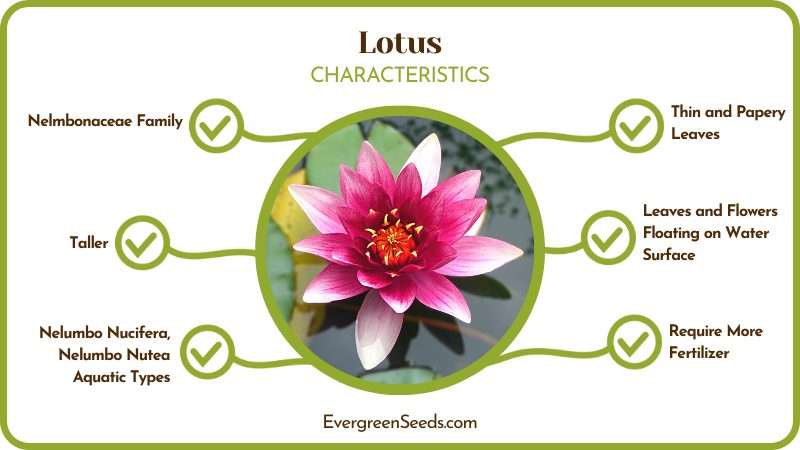
There are more intriguing aspects of this plant. Find out what they are in this section.
– Growth and Care Requirements
The lotus exclusively requires direct sunlight for it to survive. Only after providing adequate care will this plant blossom.
– Environmental Preferences
The water lily will thrive better in two to five feet of water. This plant also prefers muddy waters for proper growth. Such waters are more likely to be found in shallow streams and ponds.
Water lilies are more flexible with regards to environmental preferences as they can even grow in zones three or four. The lotus is hardy and therefore limited to zone nine.
– Height and Size
The foliage of a full-sized lotus plant can reach up to 60 inches, which is far bigger than the average size of a water lily. Each leaf of the lotus can reach a size of 18 to 36 inches. The flower of the lotus plant is about one foot across, incomparably bigger than the water lily flower.
In terms of height, the lotus can grow up to six feet. The water lily will reach a maximum of about eight inches in height.
– Seed Ripening
The seeds of the lotus ripen outside the water due to the fact that the lotus flower on water grows further outside the water surface. Like many other plants, the flower of the lotus develops into a seed high above the water. Once the seeds are ripe, they will fall into the water and are then carried by water currents until they germinate.
– Environmental Preferences
About 12 inches of water are preferable for growing the lotus. The lotus is also happier in swamps and shallow ponds.
– Fragrance
The fragrance of the lotus is less defined when compared to that of the water lily. This makes this plant preferable for individuals who are sensitive to fragrances and odors as they can also enjoy the beauty of this plant without much struggle.
– Leaf Characteristics
The lotus leaves are rather thin and papery in appearance. They do not have a cut like the one on the water lilies. Although the leaves of the lotus are inverted to the extent that they can collect water at their center, the plant has weak stems that can be easily tossed by the wind, allowing the leaves to release the accumulated water.
– Flower Attributes
The lotus has rounded petals that may appear ruffly sometimes as they are wider and larger. Take note that the carpel of the lotus plant is barrel-shaped. They are also embedded in a receptacle that is relatively enlarged. These characteristics are not evident in water lily plants.
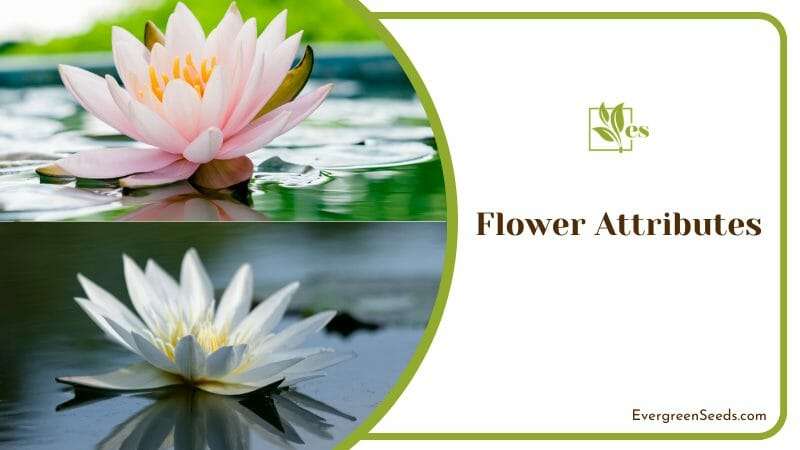
For lotus plants, the disappearance of the inflorescence leaves a seed pod that will continue to grow high above the water, which does not happen with the water lily. The flower of the lotus has an unusual androecial ring that makes it unique and decorative.
– Lotus: An Overview
The lotus, which is also called Nelumbo, is an aquatic plant that belongs to the Nelumbonaceae species. This plant has white and pink stunning flowers, just like the water lily, and this is one of the reasons why the two are often confused for each other.
Although there are many other species of the lotus, only two are solely aquatic. These are the Nelumbo nucifera and Nelumbo nutea. Both of these plants have rounded leaves that appear like inverted umbrellas on top of the water. The lotus is native to central and northern India.












